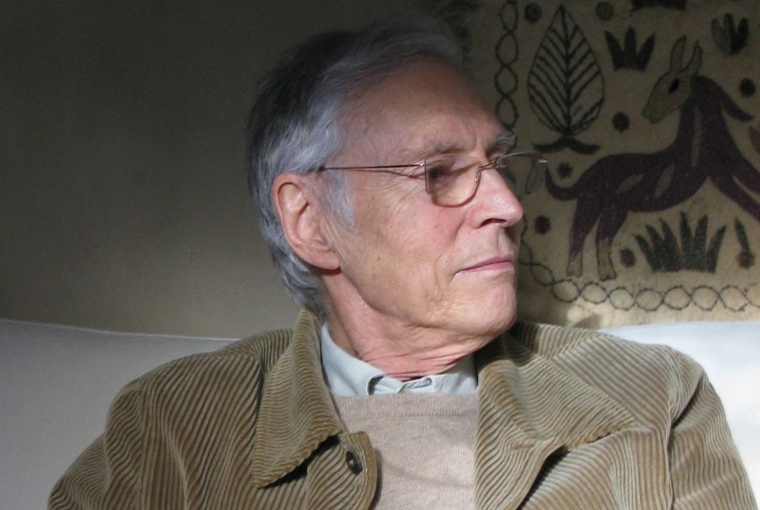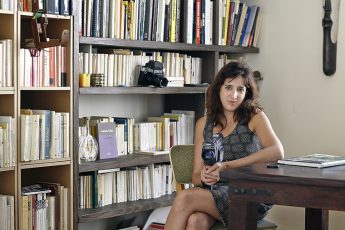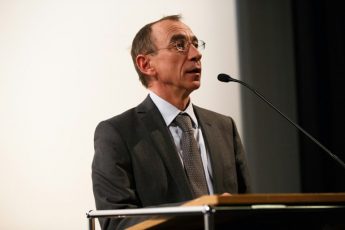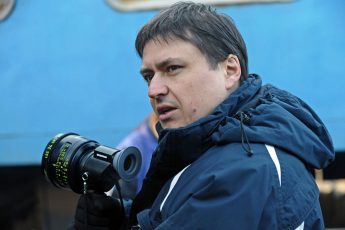
The Mill and the Cross” is a film based on a painting. Initially historian Micheal Gibson asked Polish director Lech Majewski to shoot a documentary about the painting after he had written an extensive monograph on the subject. Majewski then decided to make a feature film, with Gibson as the script writer. We met Gibson in Paris, where the film premièred at the Louvre.
How did the idea of the miller as God come to you?
I began writing a book on the subject in ’96 and I had a large reproduction of the painting which I sat looking at for about three months with a magnifying glass. What struck me was the position of the mill. Bruegel has taken great pains to place it very high, which is completely impractical; if you have a mill up on the hill like that you have to lift all the grain up and lift all the flour down; it doesn’t make sense. But visually it gives a sort of central axis to the painting. What it does is that it places the miller in the sky, exactly the place where Hieronymus Bosch paints God, parting the clouds and looking down on the world. So he has the same sort of heaven’s-eye view on the world as God does in many paintings. In a way, if you know how familiar Bruegel was with Bosch’s work and all the artists of the period that preceded his own, it seems sort of a logical interpretation. And, ah ! Also because I had read a book by Giorgio di Santillana and Hertha von Dechend. They produced a book called Hamlet’s Mill and I can sum it up very briefly for you: the gist of the book is that the earth is like a top when it turns on its axis. The axis of the earth actually moves around, now we’re pointing at the North Star but about 13,000 years ago we were pointing at the star Vega. The result of this movement, which is called the precession of the equinoxes, is that every 2,000 years at the Spring solstice, a different constellation appears on the horizon, and you still see traces of this in astrology, where we have the different ages of the world: the age of the Ram, the Fish and so on. As it happens, the authors found comparable myths which came from everywhere in the world: from the Mayas, from Mesopotania, and these myths all seem to relate the fact that at one point the mill of the heavens was stolen, dismantled and put up again somewhere else.
What exactly is the mill of the heavens?
The sky. You see you have the sky turning round like a millstone above your heads, and the axis of the world points first one place then another, its a very slow movement so you don’t see it. It does the whole circle in 26,000 years, every two thousand years however, you notice that the constellation that comes up in the heavens in the spring solstice is not the same, so this means that it takes a long period of observation to notice this, but it was well known in antiquity, it was still known in Bruegel’s day, and it was a big problem for astronomers at the time. Now it’s not a problem because we just understand that the axis of the world is moving, whereas it used to be the entire heavens that were somehow reorganising themselves every two thousand years. And in this context it also meant that empires fell and things changed. You have an echo of this in Christ arriving in the age of the fish: Pisces. In fact the fish is the sort of secret symbol for Christ. The Greek word for fish, which is ichthys, is also the acronym for Jesus Christ, Son of God, Saviour in Greek, so all this fits into a pattern. It’s a symbolic pattern and a visual pattern, and the idea of the mill as heaven’s grinding fate was a notion of Antiquity. The whole idea of astrology is that the stars determine your fate and the whole idea of Christianity is that the stars don’t decide your fate–you decide your fate by your actions.
Can you see the miller in “Way to Calvary”?
Yes, you have the mill on top of a rock, and you have a tiny little spot of a man, who’s leaning up against the mill and watching what’s going on down below.
Does the miller have a central role in Majewski’s film?
Yes, he observes everything that’s happening. He’s the one who at one point, upon receiving a sign from Bruegel, stops the mill and then everything freezes. In other words, when the mill stops, time freezes. The idea is that, if you remember the dialogue between Bruegel and his friend the banker, Jonghelinck who’s indignant, saying: “these horrible things that are being done every day, they’re beyond bearing, and if only we could stop time and confront the instant with its ugly face…” Bruegel seems to think he can do precisely that. And so he makes a sign to the miller, the miller gives the sign to his assistant who stops the mill, and everything stops. Which is a very good metaphor of the fact that a work of art, a play, a painting a novel, fixes the instant and allows us to confront it. That’s how that element comes in.
I met Majewski in I think 2004. I told him I’d just published this book in English a few years before (2001), after having translated it from the original French book which was published in 1996. When I gave it to him, he was enthusiastic so I sent him a proposal that I had written (not specifically with him in mind) for a film about the subject, but I had in mind a documentary film. He came to see me saying, no, not a documentary, but with actors! We will choose a dozen or so characters in the painting and we will follow their day from dawn to dusk. But I had a problem, which was in that case how do we manage to suggest an interpretation of the painting if we’re just following their day. But then we chose the characters together after which he said ‘OK I’m going back to Katowice, you must get to work writing!’ I had the idea that the miller saw the wind changing and simply stopped the mill. In my mind, it had some bearing upon a change in the ages of the world. But then Majewski had a better idea. Bruegel would give the signal. This added touch really gave a meaning to the whole thing.
Of course Bruegel was talking about events in his own day, but he clearly wanted to make a parallel between the death of this heretic and the death of Christ as the image of man. At one point during the film Bruegel says: “if this simple woman is going to stand in for the mother of God, we’ll have to do something her clothes”. Whereupon some women come in with beautiful draperies. If you look at the painting, you see this little group–Mary, the holy women and Saint John–painted in a style that is not at all like the rest of the painting, but rather in the style practised by artists like Van Eyck some 150 years before Bruegel.
How is the style different?
The way they are painted. You don’t notice it so much because basically this enormous painting is a miniature and I had the luck that I was allowed to stand on a stool in front of the painting with a magnifying glass in hand, going over the painting. And I realised that this was a painting which ought to be seen from about this far away (he holds his hands quite close together) and with a magnifying glass, and when you look at it like that you see all these little figures painted, almost as though it was Egon Schiele, like a caricature. The holy women of St John on the other hand, are painted very smoothly, very beautifully, their faces very carefully drawn, pathetic, expressive and so forth, which is not the case with all the rest of the crowd. The rest of the crowd are painted with great gusto.
What might have been the differences between a documentary and a film that is based on fiction?
One great disadvantage with a documentary is that you must have someone sitting somewhere and talking about the painting and doing voice-off and you explore the painting, and he explains it, which doesn’t have the same impact, here you step straight into the painting, you’re sucked into the world of Bruegel, you follow the entire day. I liked Majewski’s idea. When I saw him a couple of weeks before the screening here in Paris, I hadn’t seen the film–I saw it more or less the same time you did–and I asked him “what’s the last sequence in the film?”. And Majewski, who always plays his cards very close to his chest, said “you’ll see!” I thought the ending was very good–we are looking at the painting and it pulls back, and then you have an empty corridor and what are you waiting for? We’re waiting for people to come and see this painting and what its all about–I think that’s the visual suggestion. If I had the possibility I would make a documentary film that would simply have the camera moving over the painting from a very close range for about half an hour to forty minutes so that we could see each element. I thought if only I could get the viewers eye close enough he could see what the painting is really like, which is not possible now because you are kept one meter away from it so you can’t see all these tiny details. Near the town, not far from the great rock of the mill, there’s a little farmhouse in the farmhouse, there’s a door with the light from the sun coming through it, and in the door there’s a tiny little woman like a fly in amber about two millimetres high, and in front of the door there are about four or five little chickens which are about half a millimetre high but you can see that they are chickens, on some of the houses they have jars, hanging from the facades. I have not been able to get any enlightenment about that, I wondered whether they didn’t put them there to allow swallows to make their nests in. And then, there’s a man in the middle of the painting with a pretzel stick in his waistcoat. These are things you don’t ever see. Bruegel has this wonderful way of putting everything in his paintings for a reason. This was the original idea, but it would have changed the character of the film.
Tell me more about how a painting can freeze a moment in time?
If you look at the painting by Bruegel, the Fall of Icarus, do you remember the story of Icarus? His father makes wings for himself and his son and they fly away, but Icarus is so enthusiastic that he can fly that he flies too close to the sun and then the glue on his wings melt and he falls. In the painting they have a magnificent landscape and there’s a ship, a ploughman ploughing, a fisherman fishing and nobody sees anything and there’s just one leg still out of the water and a feather falling down, and that’s all you see. But obviously it’s a moment in time that is frozen.
But it’s also saying something about the artist and something divine?
No, I didn’t think it that way. I was thinking, do you know the philosopher Ernst Bloch? He had a statement of that effect which is : Der gerade gelelbte Augenblick ist völlig Dunkel, it means the moment you’re living in is completely obscure, you can’t really grasp it, it’s only afterwards that you can lift it up to a certain level where you can consider it and think about it. It has nothing to do with divinity or humanity, but just about the workings of the mind in time.
When they stop the mill in the film, they are talking about the tragedy of what’s happening.
That’s the banker, and we know that he knew the man who was being executed. You have to understand that in Bruegel’s day, Antwerp was a city more active, more prosperous than Venice. Economically they did more business in a month than Venice in an entire year, it was a bigger city than London and this was the period where the reformation was spreading. The urban environment was favorable to the reformation. The king of Spain who owned the country was not. So he promulgated laws which are mentioned in the dialogue, according to which heretics had to be put to death, men by the sword and the women buried alive, and these were only some of the resourceful means they had of putting people to death. People were known in the town, respected and well-known people would get arrested and put to death. And there were preachers who came and spoke in the woods, the crowd would be assembled somewhere in the woods, he would arrive with a few companions and get off and make his speech or sermon and disappear. So there was interest, familiarity, openness in Antwerp which was really a sort of center of the reformation. The prior of the Augustinians had been a fellow student with Martin Luther. So all this was a form of political and religious tension between the Spanish conception of religion and of the world, and the Flemish one. Spaniards were people who kept hold of the land and Flemings were people who were mainly involved in trade. So you have two different mentalities. And so what happens? Bruegel takes a scene which is basically a reconstruction of the execution of a heretic except that his heretic is carrying a cross and he does this obviously because he is making a comparison between this man and Christ, which is what you find in the New Testament: “whatever you do to the least of men you do to me”. This can be understood in a psychological or moral sense, which is that whatever one does to any one man one also does to the Image of Man and once that millions of people have been treated like cattle, it takes some time for certain people to realize that this is not what should be.
So Bruegel documents a sort of parable of his time in this painting?
I think he is representing the sort of execution one saw in his day. When heretics or criminals were executed it was a public show. If you read Huizinga’s the Autumn of the Middle Ages you’ll find that one city, I think it was in Flanders, bought a criminal from another city and brought him to their city to have a public execution because it was good entertainment for the public.
How does the image of Christ appear in Bruegel’s “Way to Calvary”?
Christ is right in the center of the painting but he is not the center of attention. Bruegel is very clever, he puts a grey robe on Christ and he puts him in the very centre of the painting but in front of him he puts a man in a white shirt mounted on a white horse, and the first thing the eye does is to go straight to the man in white. This man is looking behind himself with an air of displeasure: some people behind him are struggling because the soldiers are trying to take away this old man, but his wife is holding onto him and the crowd has come to look at this with open mouth. And farm laborers bearing white bags are running in all directions, because they think “if they don’t get this guy they’ll come and get me.” Bruegel is a wonderful narrator you see. He tells the story in a way that draws the eye away from the central thing but nonetheless the event of the day was the execution. Most of the people are going from the city to the place of execution to watch other people die. A few others are going into town because it’s a market day and you have two people with a calf who are going into town. It takes people some time to spot Christ unless they have studied art history. I did a test on a number of friends, I would say, try and find Christ, and one of them took more than two and a half minutes to find him.
Why do we never see the face of Christ in the movie?
Majewski didn’t tell me about this because when I attended a shooting he had an actor playing Christ with his face covered in blood – and he obviously intended to show his face at the time. I actually have a photo of Christ smoking a cigarette during a break. But I think he then came to the conclusion that one shouldn’t show his face because whatever face you give Christ, it will be inadequate to the idea one has of him.
Was Bruegel’s painting a political statement?
It was hung in a private home. It actually did belong to the prominent banker Nicolas Jonghelinck who was the brother of a sculptor. We know that he owned it because at one point he gave it as security for a loan for a friend. I don’t know if the loan was ever paid back but pretty soon the painting belonged to somebody else because now it’s in the museum in Vienna.
Would you consider the film more as a historical film or more as an art film?
It’s a focus of various possible views, artistic, ethical, historical, religious all of these converge. It’s at the crossing point of all these. In any case, it raises problems of violence and how we can deal with violence. René Girard talks about this in his book La violence et le sacrée (Violence and the Sacred.)
Somebody suggested that the film would have been nice in 3D. What do you think about that?
It’s already so much work in 2D! Majewski and his team did a fantastic job by taking the painting on a computer and eliminating all the figures in it and then using the landscape as background. So we start from a 2D situation which means you’d have to create 3D artificially.
Do you think something similar could be done with another painting?
I don’t think I know any painting that’s quite as full of events as this one, with such an attention to the realistic motivation of the people in the painting and not to the decorative value of the figures being placed there. In most Italian painting figures are placed in a sort of decorative way, he might have his hand here (Gibson places his hand on the couch elegantly) because this creates a line that is attractive for the painting. In a Bruegel painting he will have his hand here (Gibson places his hand on the chair on which I am sitting) because there’s the young lady there. So it creates a completely different form of tension inside the painting. In Bruegel’s Wedding Feast there is a man who is there playing the bagpipes, and he has stopped playing, and he’s looking very intently at something. Two men are carrying a tray, on which there are dishes with soup on them, and you can just see that he’s hungry! You don’t find this in the same way with Italian painting.
Thank you for the interview.
Interview conducted by Colette de Castro and Moritz Pfeifer




I absolutely loved the film. Watched it last night 2/07/2012 and will watch it again and again. Do have have to say that the scene which showed the ladder that reached the man on the wheel made me somewhat outraged…the ability to help had been available.